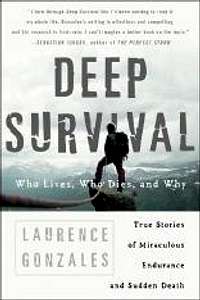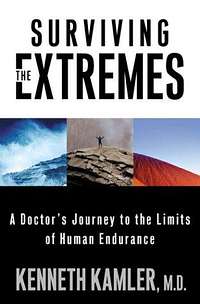-
 5314 Hits
5314 Hits
-
 81.18% Score
81.18% Score
-
 13 Votes
13 Votes
|
|
List |
|---|---|
|
|
Introduction
“No animal in its right mind ever intentionally puts itself indanger by going somewhere it doesn’t belong. Human beings, on the other
hand, are controlled by brains whose emotional and spiritual imperatives
can override the survival instinct” Kenneth Kamler, M.D., Surviving the
Extremes (St. Martin’s Press 2004) at p.5.
Probably no one who has ventured into the outdoors with the intent to seek personal challenge has failed to wonder about his or her personal physical and mental limits. Some have tested their limits and survived to tell their stories. In fact, the standard repertoire of mountaineering literature is comprised of narratives of breath-taking epics, disasters and near disasters.
The list below is a little different. It encompasses works where disciplines such as physiology, chemistry, physics, and psychology are applied to describe and analyze the adaptation (or lack thereof) of humans to hostile environments such as high altitude, deserts, jungles, the high seas, and even outer space.
Some of these works deal with the question of why some people survive life-threatening situations while others similarly situated do not. Other works focus more on the physiological responses of the human body to extreme environments. There is education, adventure-packed reading, and inspiration spread throughout the short list below. Suggestions for additions to the list are welcome.
The List
Alone: A Fascinating Study of Those Who Have Survived Long, Solitary Ordeals, Richard D. Logan, Ph.D (Stackpole Books 1993)(a study of psychological adaptation to the stress of solitary ordeals. Case studies include Maurice Herzog's harrowing descent on Annapurna; Joe Simpson's famous ordeal in the Andes after breaking his leg; Charles Lindberg flying across the Altantic; a crash survivor of a plane carrying a Uruguayan rugby team in the 1970's; and Admiral Richard Byrd's 1936 solitary 5 months in a weather hut in the Anarctic).Deep Survival: Who Lives, Who Dies, and Why, Laurence Gonzales (W.W. Norton & Company 2003) (gripping stories of disaster and survival in the context of the science and art of how humans deal with survival situations)
Extreme Outdoor Adventures, Larry Mueller and Marguerite Reiss (The Lyons Press 2008) (Twenty stories illustrating where some individuals get the capacity to survive horrific wilderness disasters. The accounts encompass animal attacks, hunting accidents, mountaineering accidents, and a plane crash in the Alaskan wilderness, among others).
Last Breath: Cautionary Tales from the Limits of Human Endurance, Peter Stark (Ballantine Books 2001) (what happens to the body and mind in the last moments of life when falling, freezing to death, drowning and other manner of death while engaged in risky outdoor activities)
Life at the Extremes: The Science of Survival, Frances Ashcroft (University of California 2000) (this volume by an Oxford physiology professor explains the physiological response of the human body to extreme environments (altitude, heat, cold, underwater, outer space) and explores the limits of human survival)
Survival of the Fittest: Understanding Health and Peak Physical Performance, Mike Stroud (Vintage 1999) (a very readable exploration of aspects of human physical performance from a scientific and evolutionary perspective and informed by the author's own experiences as a polar explorer and ultra endurance athlete)
Surviving the Extremes: A Doctor's Journey to the Limits of Human Endurance, Kenneth Kammler, M.D. (St. Martin's Press 2004) (medical case studies based upon the author's practice of medicine in the most hostile environments on earth including high altitude, desert, high seas, jungle and underwater environments)
The Survivor's Club: The Secrets and Science That Could Save Your Life, Ben Sherwood (Grand Central Publishing 2009) (stories of survival situations from airplane crashes to animal attacks to The Holocaust, including lessons from elite military unit survival schools, to the end of analyzing the question, does it make a difference what kind of individual you are in terms of surviving dire situations?)
[img:502749:alignright:small:Includes an "Am I a survivor?" test]
[img:381999:alignleft:small:135 miles in Death Valley heat]
[img:537459:alignright:small:A bit dense but worth the read]
The Unthinkable: Who Survives When Disaster Strikes, Amanda Ripley (Crown 2008) (an exploration of the factors that seem to determine why some people survive, and even perform well in crisis or disaster situations, while others do not. Among other sources, the author studied the behavior of survivors of the 9/11 attacks and the training of elite military units for operating in extreme pressure situations)
The Worst Journey in the World, Apsley Cherry-Garrard (Carrol & Graf Publishers 1922)(perhaps the greatest adventure book ever. At 24, the author accompanied Robert F. Scott to the Anarctic on Scott's doomed quest to be the first to reach the South Pole and here recounts the journey across forbidding, inhospitable terrain)
To The Edge: A Man, Death Valley, and the Mystery of Endurance, Kirk Johnson (Warner Books 2002) (a former non-runner provides his account of training for and running the Badwater Ultramarathon, the annual 135-mile race between Badwater, California and the Whitney Portal, done in the torrid temperatures of late July).








